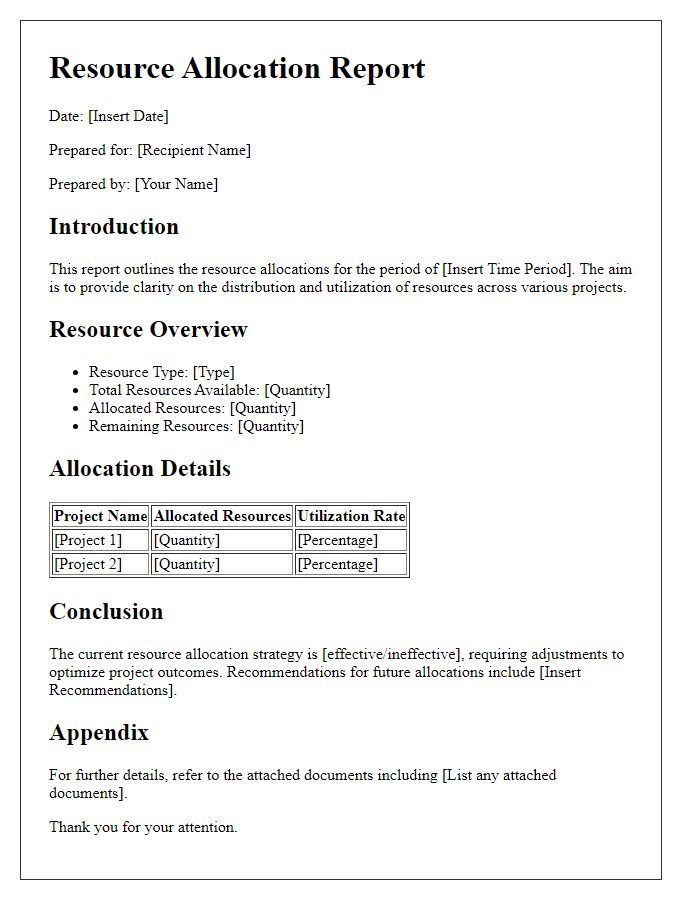In today's fast-paced industry, keeping track of raw material usage is crucial for operational efficiency and sustainability. Crafting a comprehensive report not only highlights your resource consumption but also identifies areas for optimization. This guide will walk you through a streamlined letter template that ensures all necessary details are communicated clearly and professionally. Ready to streamline your reporting process? Let's dive in!

Title and Date
Raw Material Usage Report Date: [Insert Date Here] This report details the consumption of raw materials, including quantities, types, and sources, over a specified period. It aims to provide insights into material efficiency and inventory levels while assessing potential cost-saving opportunities in production processes. Key raw materials analyzed include steel (metric tons), textiles (meters), and polymers (kilograms), with emphasis on supplier performance and delivery timelines. The report also evaluates variance from projected usage against actual metrics, enabling strategic planning for future procurement activities.
Introduction and Purpose
A raw material usage report provides crucial insights into the consumption patterns of various materials utilized within manufacturing processes. This report aims to document the quantities of raw materials (such as steel, plastic, and wood) consumed during a specified period, enabling accurate tracking of inventory levels. It assists in understanding production efficiency, ensuring cost management, and identifying potential waste reduction strategies. Additionally, this analysis supports sustainability initiatives by highlighting resource utilization and guiding materials procurement decisions for future production cycles.
Detailed Raw Material Usage Data
The detailed raw material usage report provides essential insights into resource allocation and consumption levels for specific materials utilized in production processes. The report will include quantitative data (in kilograms or tons) detailing the usage of various raw materials, such as steel (commonly used in construction, with global demand reaching 1,500 million metric tons in 2023) and aluminum (widely used in automotive and aerospace industries, with usage estimated at 60 million tons). Each material section will include supplier names, batch numbers, procurement dates, and costs associated with each type of raw material. Specific events, such as fluctuations in demand during seasonal production peaks, may also be noted to identify trends. The report will be organized by production facility locations, noting how regional factors may influence material availability and pricing, enabling better forecasting and strategic planning for future projects.
Analysis and Insights
The raw material usage report provides critical insights into inventory levels, consumption rates, and procurement strategies. Tracking raw materials such as steel (used in construction projects), wood (for furniture manufacturing), and chemicals (in pharmaceuticals) reveals patterns in resource allocation. For instance, a decline in steel availability could correlate with increased construction activity in urban areas like New York City, driving up costs. Additionally, comparing year-over-year usage metrics highlights potential inefficiencies or waste, allowing businesses to adjust operational practices. Effective analysis of these factors enables companies to optimize their supply chain operations, reduce costs, and enhance sustainability efforts.
Conclusion and Recommendations
A comprehensive analysis of raw material usage reveals opportunities for optimization within the production processes of manufacturing facilities. The report indicates that materials such as Steel (commonly used in automotive industries), Wood (predominantly in furniture manufacturing), and Polypropylene (widely utilized in packaging) exhibit variances in consumption rates. Recommendations include implementing a Just-In-Time (JIT) inventory system to reduce waste, conducting regular audits for process efficiency, and investing in advanced technology for real-time usage monitoring. Additionally, exploring alternative sustainable materials can enhance operations and align with environmentally responsible practices, potentially lowering costs and improving brand reputation in the competitive market.












Comments